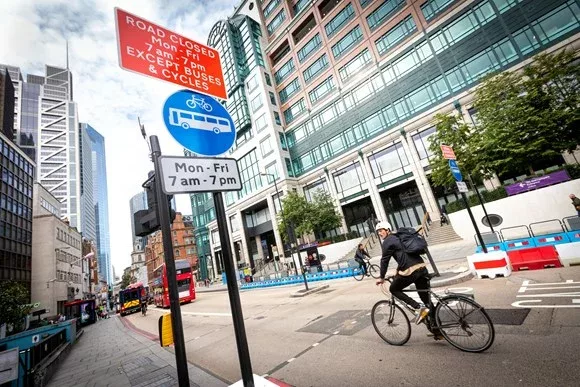Transport for London (TfL) will be making its scheme on the A10 Bishopsgate permanent to help more people walk, cycle and use public transport, amid data suggesting that the scheme has led to faster bus journey times and thousands of safer cycle journeys each day.
In August 2020, TfL introduced a series of temporary changes along the road in response to the pandemic, which were designed to make it safer and easier for people to walk, cycle and use public transport. The changes implemented included new restrictions on vehicles using the road on weekdays between 0700 and 1900 to ensure that there was enough room for people to cycle on the road safely. Wider footways were also constructed along the corridor to ensure social distancing and a number of banned turns were introduced along the road.
TfL data suggests that the changes have played a vital role in supporting sustainable travel along the corridor. Data shows that the performance of buses on the Bishopsgate corridor has significantly improved since the changes were introduced, with bus journey times on the corridor two minutes per km faster northbound and one and a half minutes per km faster southbound. TfL data also demonstrates that very high numbers of people are using the Bishopsgate scheme to cycle, with monitoring so far showing an average of 7,500 people cycling on Bishopsgate per day since the changes were introduced, which is up from around 5,700 in 2019. Numbers have peaked at 9,000 cyclists on some days. Provisional safety data also shows a reduction in overall collisions. Enabling more people to walk, cycle and use public transport is essential to a healthier and more sustainable city for all Londoners and TfL remains committed to its Vision Zero goal of eliminating death and serious injury on the transport network.
Last year, TfL launched a public consultation into the future of the scheme on the A10 Bishopsgate and if it should be made permanent and received more than 2,150 responses. Enabling more people to use healthier and more sustainable forms of travel is vital to reducing congestion and air pollution.
The decision to make the changes permanent will be followed by short-term upgrades to improve the streetscape, as well as further safety and public realm improvements in future years.
Helen Cansick, TfL’s Head of Healthy Streets Investment, said: “We’re determined to ensure that people can walk and cycle safely across the capital and our data suggests that the changes we’ve made along Bishopsgate have played an important role in promoting healthy and sustainable ways of travelling in London. As a result of our bold changes here, it has become much safer for vulnerable road users, and bus journey times have reduced.”
Will Norman, London’s Walking and Cycling Commissioner, said: “These changes at Bishopsgate have made a huge difference to the way people travel through the area, which is why I’m delighted they’ll now be made permanent. The area has become safer for both pedestrians and cyclists, and bus journey times have reduced thanks to the new vehicle restrictions on the road. Schemes like this support our aim to continue building a safer, greener and fairer Londoner for everyone.”
TfL launched a major new cycling action plan last month which set out its commitment to further boost cycling numbers across the capital and ensure that people cycling become more representative of London’s diverse communities. The past two decades have seen huge growth in cycling in the capital, with a 155 per cent increase in the number of daily cycle journeys since 2000. This includes a 13 per cent increase in daily cycle journeys between 2019 and 2022, despite Londoners making fewer trips across all transport modes in 2022 than in 2019.
Meanwhile, TfL and London boroughs have more than tripled the size of the London-wide strategic cycle network, from 90km in 2016 to more than 340km in 2023, meaning that more than one in five Londoners now live near the Cycleway network.
TfL has also committed to further measures to ensure that continued progress is made towards its Vision Zero goal of eliminating death and serious injury on the roads, including developing a pipeline of transformative junction safety improvements. TfL and London Councils recently announced that they are moving forward with plans to improve road safety in London by making changes to London’s pioneering Direct Vision Standard (DVS) based HGV safety permit scheme. Under previously agreed arrangements, from 28 October 2024, Heavy Goods Vehicles (HGV) over 12 tonnes will be required to have a minimum three-star DVS rating or fit a system of updated safety features – the Progressive Safe System – to the vehicle in order to operate in Greater London.
TfL announced last autumn that it will restart work on paused schemes to make the capital’s roads safer and more attractive for those walking and cycling, following vital investment being secured as part of the latest funding agreement with Government. Since April last year, TfL and boroughs have delivered 24km of new or upgraded Cycleways and there are plans to open at least another 40km by March 2024.
TfL has so far reduced danger at 44 junctions across London as part of its Safer Junctions programme, with work at a further two locations set to start later this year. All locations in the Safer Junctions programme had higher-than-average collision rates and this improvement work is a vital part of TfL’s Vision Zero ambition.






















